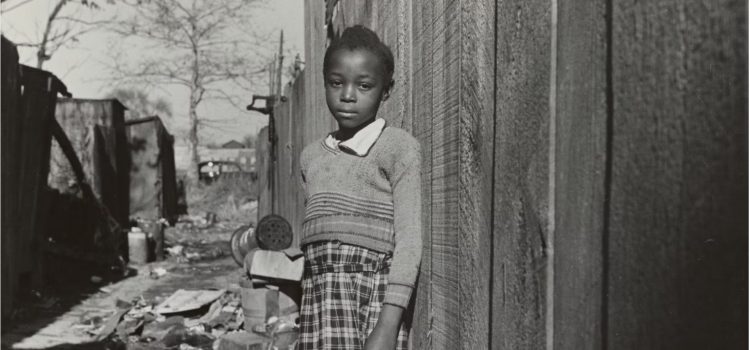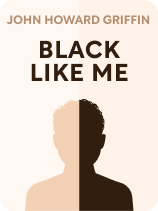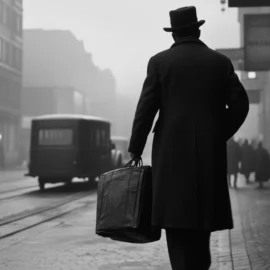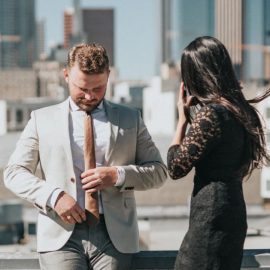

This article is an excerpt from the Shortform book guide to "Black Like Me" by John Howard Griffin. Shortform has the world's best summaries and analyses of books you should be reading.
Like this article? Sign up for a free trial here.
What is the cycle of oppression? What are the four steps of the cycle? What was racial oppression like in 1950s America?
In 1959, John Howard Griffin wrote Black Like Me to convince white Americans that the U.S. was not the racism-free country they thought it was. The book describes Griffin’s account of the segregated South and the cycle of oppression faced by Black Southerners.
Read on to learn more about the cycle of oppression in the 1950s, according to Griffin.
What is the Cycle of Oppression?
In Black Like Me, John Howard Griffin argues that it was challenging for Black people to escape anti-black stereotypes because these stereotypes trapped them in a vicious cycle of oppression. Let’s break down the steps of this cycle as Griffin sees them.
Step 1: Oppression. Systemic racism deprived Black people of dignity and opportunities to thrive.
Step 2: Violence and escape. According to Griffin, many Black Southerners engaged in “immoral” behavior because systemic racism robbed them of opportunities, dignity, and power. He explains that their anger about this racism often turned to violence, and they found refuge in physical forms of escape (such as sex and drugs). Griffin argues that these behaviors weren’t evidence that Black people were innately violent and indulgent—rather, these behaviors reflected the harmful circumstances of oppression and what it pushed Black people to do.
Step 3: Stereotype formation. White people mistakenly assumed that Black people’s “immoral” behaviors reflected their innate characteristics, rather than the circumstances of oppression. As a result, white people formed and perpetuated antiblack stereotypes.
Step 4: Further oppression. White people used racist stereotypes as evidence that Black people were inferior and didn’t deserve the same civil rights and opportunities as white people. This further perpetuated Black people’s oppression—and it strengthened these stereotypes. The cycle continued, making it increasingly hard for Black people to escape these stereotypes (and racial oppression more generally).
Oppressive Double Binds
One philosophy professor argues that double binds are a feature of all forms of oppression. She defines an “oppressive double bind” as a situation in which you have two choices—to resist your oppression or not—and either way, you reinforce your own oppression. If you choose to stay silent about your oppression, it continues. But if you do speak up, you face oppression for speaking up.
For example, imagine you’re a gay man who’s stereotyped and harassed for being “oversensitive.” If you say nothing, your harassers won’t stop. But if you do speak up, your harassers may interpret your complaints as further evidence that you’re oversensitive.
The philosophy professor argues that because oppressive double binds constrain your options, you should forgive yourself for having to make “imperfect choices.” You shouldn’t be overly self-critical when you choose to be silent about your oppression or resist it. Instead, you should recognize that when you face oppression, your choices are constrained and there’s no perfect option.
For instance, the gay man might choose to be silent to protect himself—or he might choose to speak up so he has the satisfaction of being courageous. Both choices are imperfect because neither leads to the ultimate goal—complete freedom from oppression. However, the man should forgive himself for making either choice because it’s not his fault that homophobia put him into an oppressive double bind.
| Modern-Day Experts’ Ideas on Racial Oppression Ideas from today’s experts on racism both overlap with and differ from the ideas Griffin expresses about the cycle of oppression. Let’s compare and contrast their perspectives with each of the steps in Griffin’s cycle. Step 1: Oppression. In Black Like Me, Griffin mostly explores the oppression faced by Black men. As Ijeoma Oluo explains in So You Want to Talk About Race, the concept of intersectionality recognizes that someone who has more than one marginalized identity may experience racism differently. Therefore, a Black woman may experience Griffin’s cycle of oppression differently than a Black man might since she experiences both racism and sexism. For instance, some writers claim that Black women experience the effects of colorism more than Black men do because colorism closely involves beauty standards and women face extra pressure to be beautiful. Step 2: Violence and escape. Griffin’s idea that oppression leads Black people to engage in immoral behavior is an example of what Ibram X. Kendi calls the “oppression-inferiority thesis” in How to Be An Antiracist. This is the idea that oppressive systems make you inferior. Kendi traces the root of this idea to the 19th century when abolitionists were trying to end slavery. Some abolitionists tried to persuade people to join their efforts by claiming that Black people weren’t naturally inferior—rather, slavery had made them behave in inferior ways. Kendi claims that this oppression-inferiority thesis, while well-intentioned, is nonetheless a racist idea because it’s still rooted in the belief that one racial group is inferior to another. Step 3: Stereotype formation. In Biased, psychologist Jennifer Eberhardt explains that some stereotypes take the form of implicit biases: unconscious biases we form when we associate a group of people with the category of “good” or “bad.” People with antiblack implicit biases sometimes unknowingly perpetuate antiblack stereotypes. Eberhart claims that there are ways for white people to recognize and put an end to these unconscious racial biases. One strategy is to seek out and listen to stories of others’ experiences with racism. As you empathize with storytellers, you develop an awareness of your own biases. A recent study found that empathy exercises such as this can reduce teachers’ antiblack bias. Step 4: Further oppression. Psychologists emphasize that social roles factor into cycles of oppression. Due to stereotypes, people are more likely to fulfill some social roles over others, and those roles then reinforce the stereotypes that landed them there. This can make it hard for people to adopt social roles beyond those they’re stereotyped to have. For example, the stereotype that girls aren’t good at math and science may reduce the number of female scientists, and the low number of female scientists may further perpetuate the stereotype that girls aren’t good at math and science. According to some psychologists, policies that ensure people are equally distributed among social roles can uproot these stereotypes. |

———End of Preview———
Like what you just read? Read the rest of the world's best book summary and analysis of John Howard Griffin's "Black Like Me" at Shortform.
Here's what you'll find in our full Black Like Me summary:
- The 1959 story of a white man who spent six weeks living as a Black man
- The brutal racism Black southerners faced in the mid-1900s
- Griffin’s insights about hope for racial progress in the South






